Visualizing and Quantifying Fluid Flow in Multi-Coal Reservoirs Using Three-Dimensional Monitoring Data
Abstract
1. Introduction
2. 3D Monitoring Methodology for Fluid Migration Dynamics in MCR
2.1. Experimental Setup and Procedure
2.2. 3D Measurement of Fluid Pressure Data
3. 3D Visualization and Quantitative Characterization of Fluid Migration
3.1. 3D Visualization of Fluid Migration
- Save data: Store the fluid pressure data collected by the sensors in an Excel file;
- Establish database: Create a database ‘data’ containing the sensor coordinates (see Figure 2b) and the fluid pressure values;
- Read data: Use the xlsread function in Matlab R2022a to read the target data from the ‘data’ database;
- Divide grid: Perform grid division using the linspace function;
- Interpolate data: Use the griddata function to interpolate the limited experimental fluid pressure data;
- Plot flow field: Generate a 3D vector plot of the flow field using the quiver (x, y, z, u, v, w) command. The vector arrows represent vectors (u, v, w) originating from the sensor location (x, y, z), where u, v, and w are the reservoir pressure differences between adjacent measurement points in the X, Y, and Z directions, respectively.
- Plot isobars: Use the contour function to plot isobars.
3.2. Quantitative Characterization of Fluid Migration Pathways
4. 3D Spatial Distribution of Fluid and Response Characteristics of Its Quantitative Characterization Parameters
4.1. 3D Spatial Distribution of Fluid and Characteristic Parameter Response
4.2. The Effect of Fluid Pressure on the 3D Spatial Distribution of Fluid and Its Characteristic Parameter Response
4.3. The Effect of In Situ Stress on the 3D Spatial Distribution of Fluid and Its Characteristic Parameter Response
5. Conclusions
Author Contributions
Funding
Data Availability Statement
Conflicts of Interest
References
- Zhao, Z.; Liu, D.M.; Cai, Y.D.; Qiu, F.; Sun, F.R. Gas-bearing characteristics of coal measure strata and logging evaluation of fluid pressure systems. Phys. Fluids 2025, 37, 046618. [Google Scholar] [CrossRef]
- Psaltis, S.; Farrell, T.; Burrage, K.; Burrage, P.; McCabe, P.; Moroney, T.; Turner, I.; Mazumder, S. Mathematical modelling of gas production and compositional shift of a CSG (coal seam gas) field: Local model development. Energy 2015, 88, 621–635. [Google Scholar] [CrossRef]
- Zhang, J.X.; Li, L.J.; Li, B.; Ding, S.M.; Guo, J.J.; Wang, Z.F.; Zhang, F.; Feng, Y.H. Multifractal characteristics on pore structure of grouted coal using nuclear magnetic resonance for anti–seepage evaluation. Phys. Fluids 2025, 37, 046622. [Google Scholar] [CrossRef]
- Li, H.; Liao, J.J.; Liu, R.; Hong, Y.D.; Lu, J.X.; Cao, J.Y. Coupling effect of high temperature steam-liquid nitrogen cyclic treatment on pore iteration and fluid flow behavior in bituminous coal. Phys. Fluids 2024, 36, 112001. [Google Scholar] [CrossRef]
- Liu, Y.X.; Gao, Y.; Wang, G.; Cheng, W.M.; Xu, C.H.; Cheng, J.X. Development of experimental system for rock anisotropic seepage under true triaxial stress. Geomech. Energy Environ. 2025, 42, 100677. [Google Scholar] [CrossRef]
- Liu, Y.X.; Jiang, C.R.; Wang, G.; Gao, Y.; Cheng, J.X.; Ni, G.H. Evolution of the hydraulic wetting path in fractured coal under true triaxial stress and the influence mechanism of fracture orientation. J. Hydrol. 2024, 640, 131692. [Google Scholar] [CrossRef]
- Zhang, J.X.; Feng, G.D.; Li, B.; Zhou, H.Q.; Guo, J.J.; Lu, W.Y. Modelling of multifield coupling and boreholes placement for hydraulic flushing and engineering applications. Int. J. Geomech. 2025, 25, 04024335. [Google Scholar] [CrossRef]
- Zhang, J.X.; Jiang, Y.L.; Li, B.; Guo, J.J.; Lu, W.Y.; Qu, L.N. Modeling and coupling analysis of enhanced coalbed methane recovery by gas injection. Int. J. Numer. Anal. Met. 2024, 48, 1931–1948. [Google Scholar] [CrossRef]
- Tang, Y.H.; Li, B.B.; Li, J.H.; Ding, Y.N.; Zeng, X.W.; Cao, J. Modeling apparent permeability of coal: Incorporation of slippage effect and gas pressure decline. Phys. Fluids 2025, 37, 053605. [Google Scholar] [CrossRef]
- Meng, Y.; Li, Z.P.; Lai, F.P.; Chen, W.M.; Zhao, K. An in situ study on coalbed methane seepage related to multiple physical fields: A case study from the Qinnan-East Block in the Qinshui Basin, China. Phys. Fluids 2024, 36, 047109. [Google Scholar] [CrossRef]
- Zeng, Q.S.; Wang McPherson, B.J.; McLennan, J.D. Modeling competitive adsorption between methane and water on coals. Energy Fuels 2017, 31, 10775–10786. [Google Scholar] [CrossRef]
- Li, J.; Wang, G.; Ning, Z.F.; Huang, Q.M.; Lyu, F.; Liu, B. Effect of slickwater on methane adsorption in coal: Experiment and molecular simulation. Energy Fuels 2024, 38, 5206–5217. [Google Scholar] [CrossRef]
- Lin, L.; Lu, H.; Huang, L.G.; Luo, P.Y. A molecular dynamics study of methane/water diffusion and water-blocking effects in coalbed methane. Fuel 2025, 386, 134234. [Google Scholar] [CrossRef]
- Arif, M.; Barifcani, A.; Lebedev, M.; Iglauer, S. CO2-wettability of low to high rank coal seams: Implications for carbon sequestration and enhanced methane recovery. Fuel 2016, 181, 680–689. [Google Scholar] [CrossRef]
- Qian, Y.A.; Liu, T.; Zhai, C.; Wen, H.D.; Zhang, Y.B.; Zheng, M.H.; Xu, H.X.; Xing, D.Y.; Gan, X.K. Real-time monitoring and analysis of hydraulic fracturing in surface well using microseismic technology: Case insights and methodological advances. Int. J. Min. Sci. Technol. 2025, 35, 619–638. [Google Scholar] [CrossRef]
- Kumar, S.; Chandra, D.; Hazra, B.; Vishal, V.; Ranjith, P.G.; Das, A.; Ahuja, M.; Ghosh, S. Integration of fluid-invasive, scattering, and imaging methods in resolving pore structures in coal and shale. Fuel 2025, 395, 135185. [Google Scholar] [CrossRef]
- Dong, K.; Zhong, D.L.; Lu, Y.Y.; Yan, J.; Dai, W.X. Facilitating desorption and diffusion of coalbed methane by wetting-corrosion: Perspectives from the change of pore structure. J. Nat. Gas Sci. Eng. 2023, 119, 205138. [Google Scholar] [CrossRef]
- Wang, F.; Yao, Y.B.; Wen, Z.A.; Sun, Q.P.; Yuan, X.H. Effect of water occurrences on methane adsorption capacity of coal: A comparison between bituminous coal and anthracite coal. Fuel 2020, 266, 117102. [Google Scholar] [CrossRef]
- Massarotto, P.; Iyer, R.S.; Elma, M.; Nicholson, T. An experimental study on characterizing coal bed methane (CBM) fines production and migration of mineral matter in coal beds. Energy Fuels 2014, 28, 766–773. [Google Scholar] [CrossRef]
- Amani, P.; Firouzi, M. Uninterrupted lift of gas, water, and fines in unconventional gas wells using foam-assisted artificial lift. J. Nat. Gas Sci. Eng. 2023, 114, 204977. [Google Scholar] [CrossRef]
- Ma, M.; Shakeel, Y.; Babatunde, K.; Emami-Meybodi, H. Modeling of adsorption-controlled binary gas transport in ultratight porous media. Geoenergy Sci. Eng. 2024, 244, 213414. [Google Scholar] [CrossRef]
- Li, Q.X.; Xu, J.; Shu, L.Y.; Yan, F.Z.; Pang, B.; Peng, S.J. Exploration of the induced fluid-disturbance effect in CBM co-production in a superimposed pressure system. Energy 2022, 265, 126347. [Google Scholar] [CrossRef]
- Li, Q.X.; Shu, L.Y.; Xu, J.; Peng, S.J.; Yan, F.Z.; Huo, Z.G.; Liu, D.; Li, C.; Zhou, B. Experimental study on interlayer interference effect of CBM commingled production in a multi-pressure system under output control mode. Fuel 2023, 350, 128812. [Google Scholar] [CrossRef]
- Wang, Z.W.; Qin, Y. Physical experiments of CBM coproduction: A case study in Laochang district, Yunnan province, China. Fuel 2019, 239, 964–981. [Google Scholar] [CrossRef]
- Wang, Z.W.; Qin, Y.; Li, T.; Zhang, X.Y. A numerical investigation of gas flow behavior in two-layered coal seams considering interlayer interference and heterogeneity. Int. J. Min. Sci. Technol. 2021, 31, 699–716. [Google Scholar] [CrossRef]
- Jia, L.; Wang, L.; Cheng, Y.P.; Xu, J.; Nie, B.S.; Peng, S.J. Advanced physical simulation technique for investigating coalbed methane coproduction in multicoal seams. Energy Fuels 2025, 39, 1981–1997. [Google Scholar] [CrossRef]
- Shen, Y.L.; Qin, Y.; Wang, G.G.X.; Guo, Y.H.; Shen, J.; Gu, J.Y.; Xiao, Q.; Zhang, T.; Zhang, C.L.; Tong, G.C. Sedimentary control on the formation of a multi-superimposed gas system in the development of key layers in the sequence framework. Mar. Pet. Geol. 2017, 88, 268–281. [Google Scholar] [CrossRef]
- Chen, Y.H.; Luo, J.H.; Hu, X.Y.; Yang, Y.G.; Wei, C.T.; Yan, H.P. A new model for evaluating the compatibility of multi-coal seams and its application for coalbed methane recovery. Fuel 2022, 317, 123464. [Google Scholar] [CrossRef]
- Guo, C.; Qin, Y.; Sun, X.Y.; Wang, S.Q.; Xia, Y.C.; Ma, D.M.; Bian, H.Y.; Shi, Q.M.; Chen, Y.; Bao, Y.; et al. Physical simulation and compatibility evaluation of multi-seam CBM co-production: Implications for the development of stacked CBM systems. J. Petrol. Sci. Eng. 2021, 204, 108702. [Google Scholar] [CrossRef]
- Zeng, L.B.; Zhang, Y.Z.; Li, Y.C.; Wang, X.Y.; Shi, J.X.; Dong, S.Q. Coexistence of coalbed methane, shale gas, and tight sandstone gas in coal measure strata: A case study from the southern Qinshui Basin, China. AAPG Bull. 2025, 109, 637–657. [Google Scholar] [CrossRef]
- Jia, L.; Peng, S.J.; Xu, J.; Yan, F.Z.; Chen, J.R.; Wu, B.; Chen, Y.X. On the evolution mechanism of permeability during gas drainage: Insights from deformation field, gas pressure field and temperature field. Process Saf. Environ. 2022, 162, 825–836. [Google Scholar] [CrossRef]
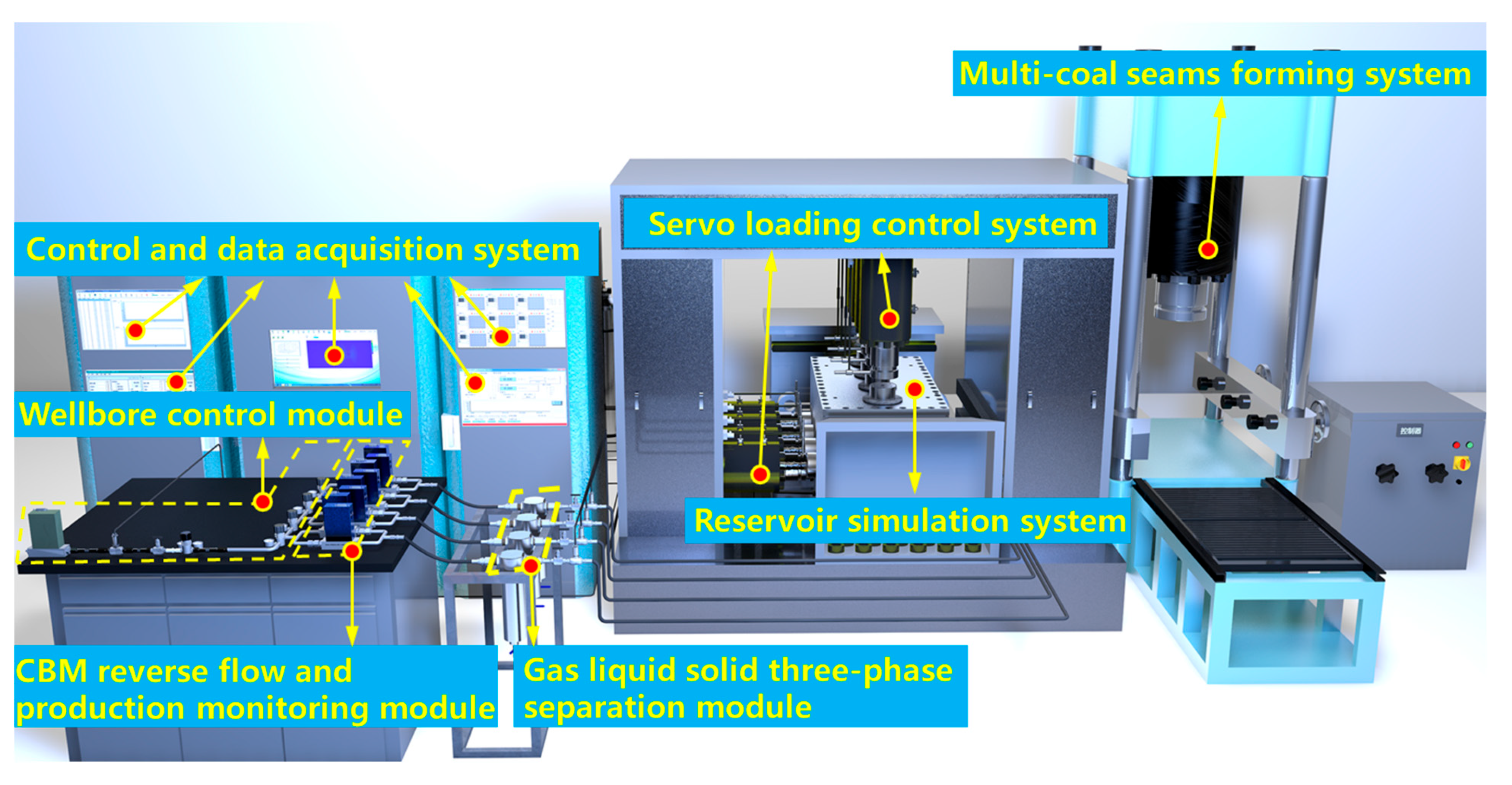

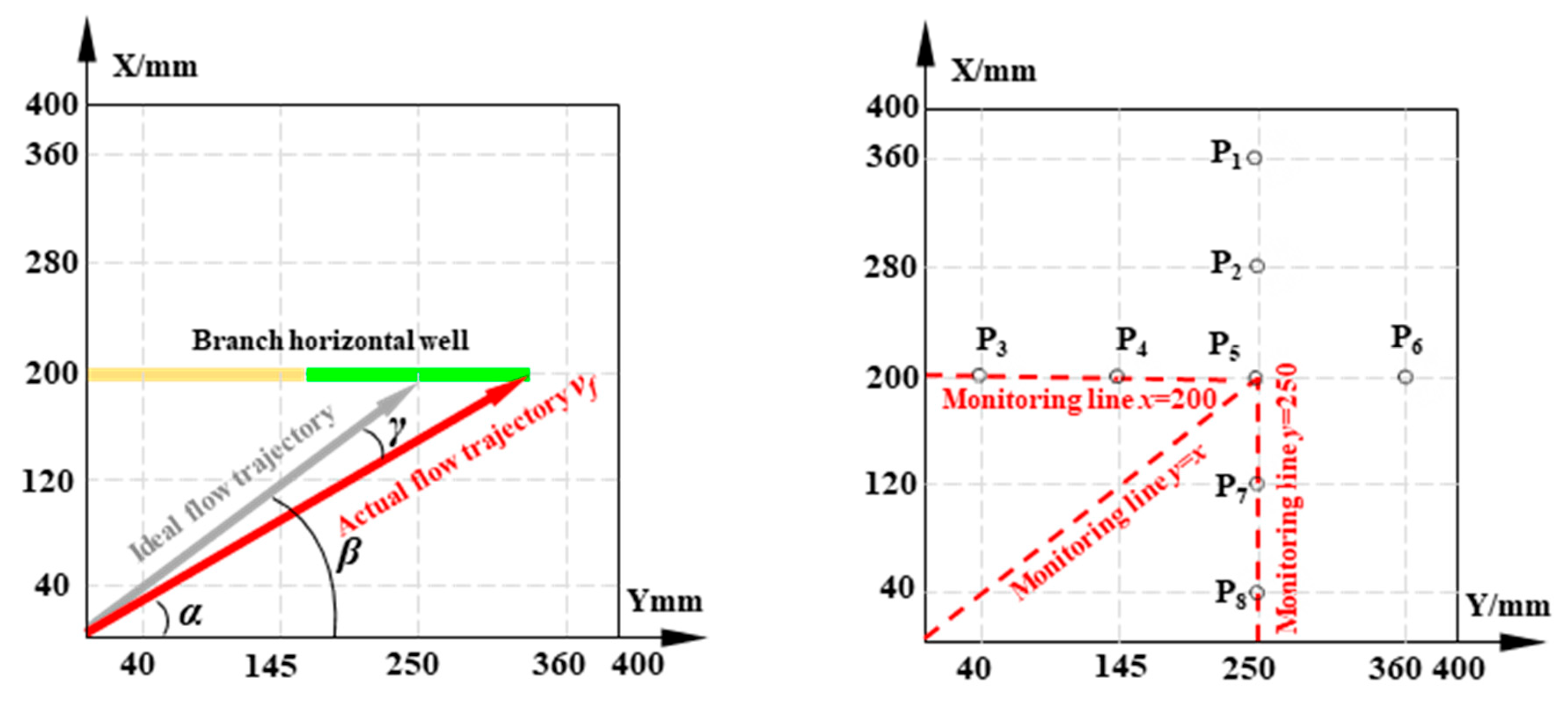
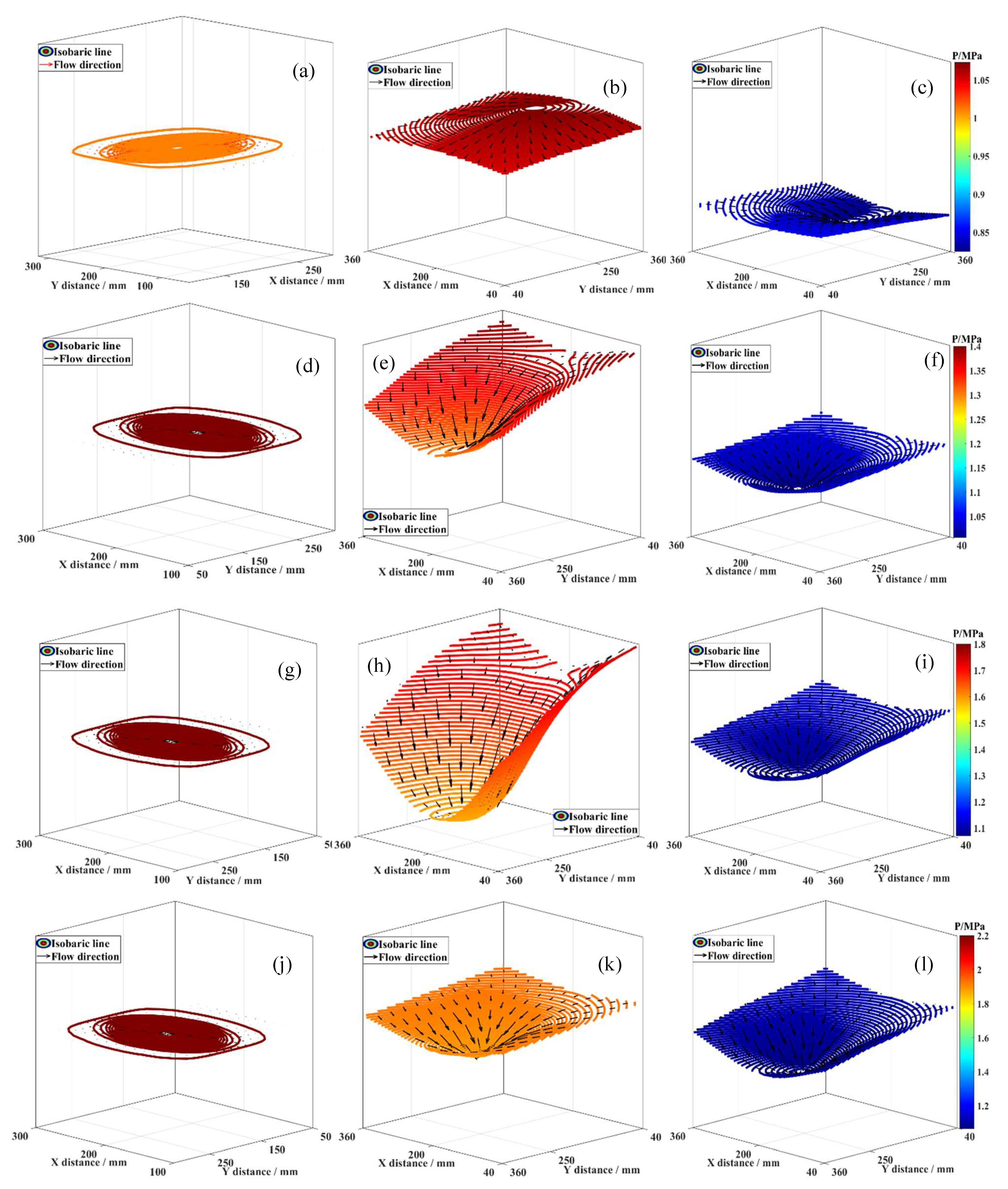


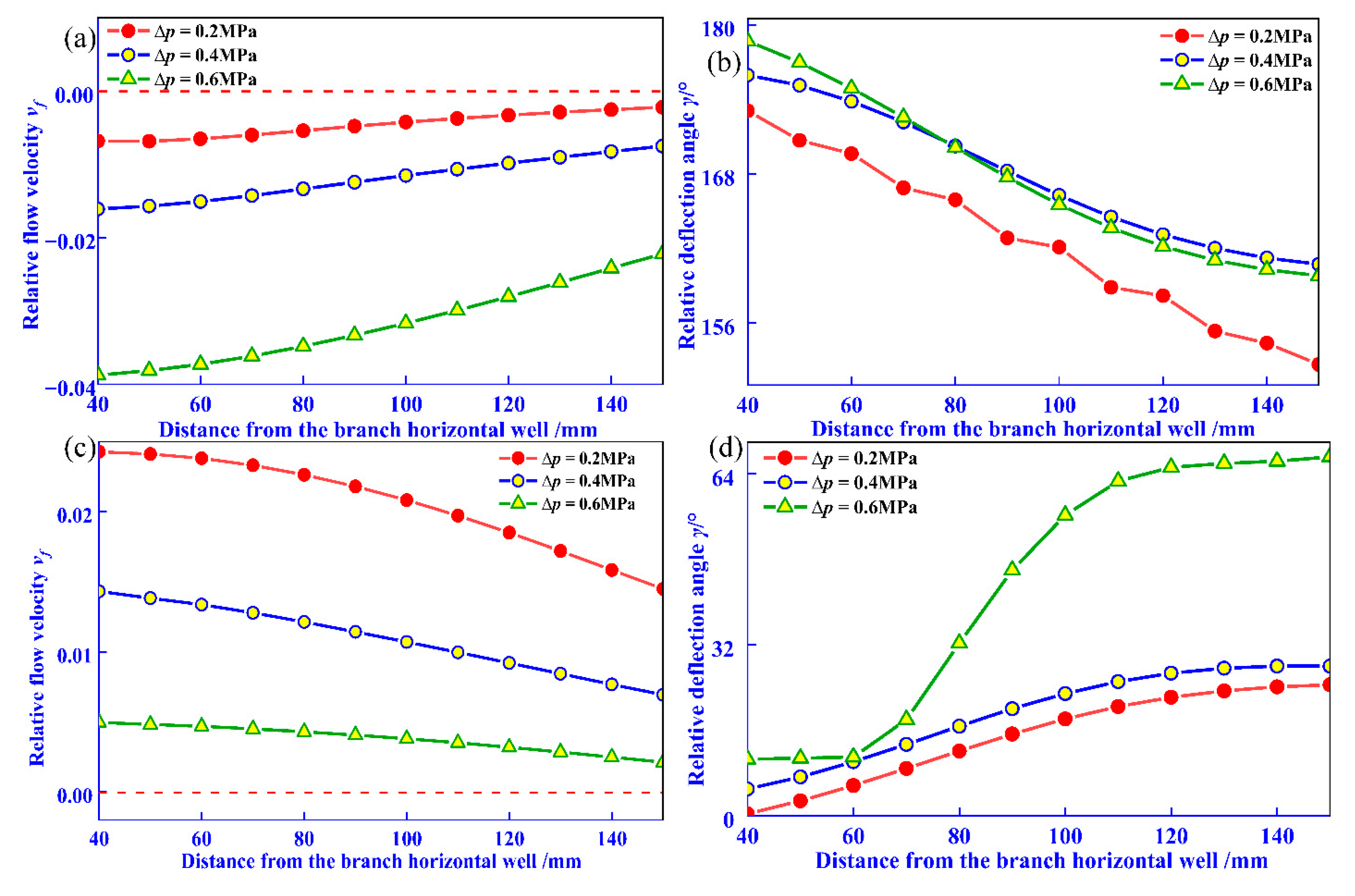

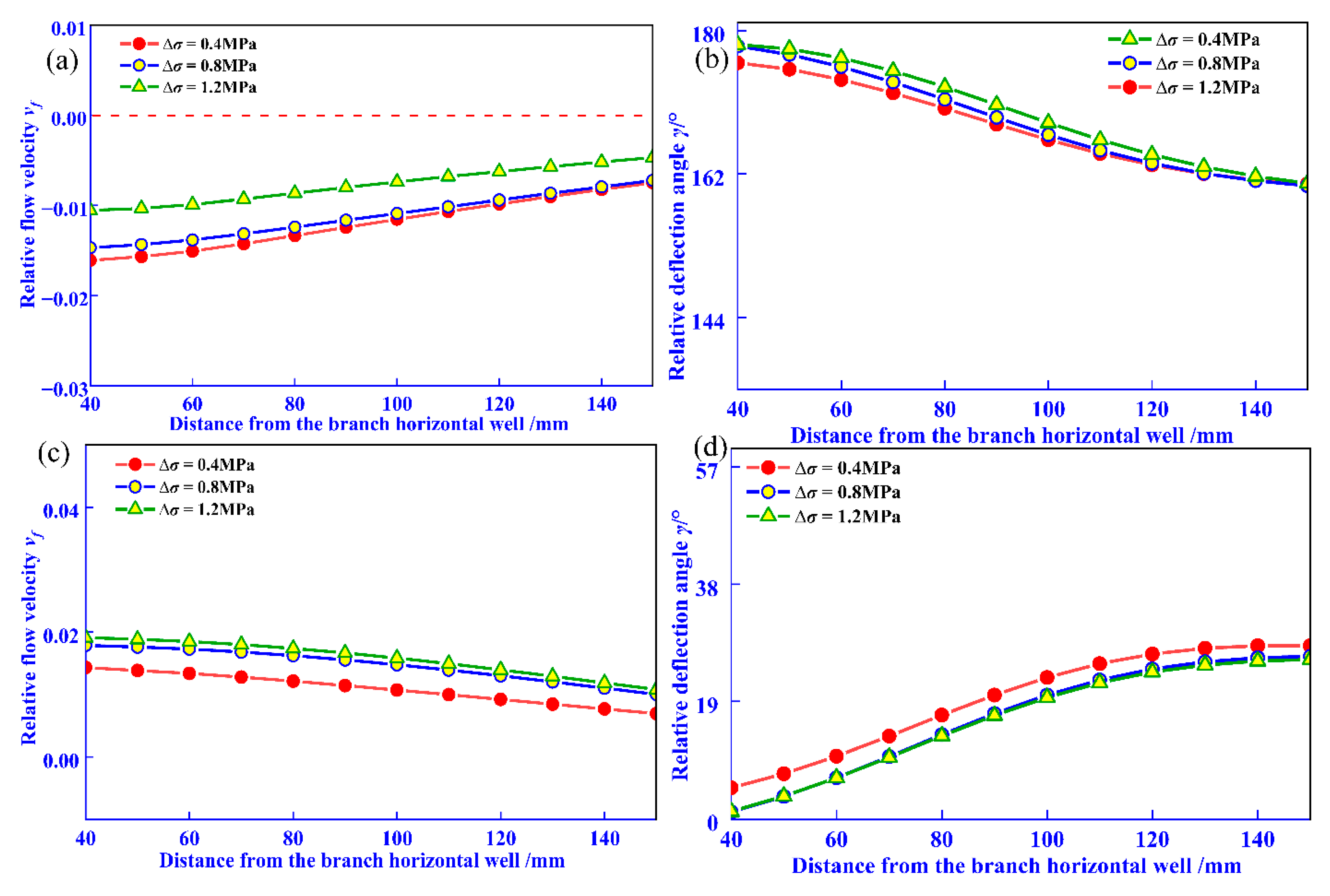
| No. | σ/MPa | p/MPa | |||||||||||
|---|---|---|---|---|---|---|---|---|---|---|---|---|---|
| σH1 | σH2 | σH3 | σH4 | σV | σh1 | σh2 | σh3 | σh4 | PI | PII | PIII | PIV | |
| Group B | 3.5 | 3.9 | 4.3 | 4.7 | 3.2 | 2.5 | 2.8 | 3.1 | 3.4 | 1.0 | 1.4 | 1.8 | 2.2 |
| 3.5 | 4.3 | 4.7 | 5.1 | 3.2 | 2.5 | 3.1 | 3.4 | 3.7 | |||||
| 3.5 | 4.7 | 5.1 | 5.5 | 3.2 | 2.5 | 3.4 | 3.8 | 4.1 | |||||
| Group A | 3.5 | 3.9 | 4.3 | 4.7 | 3.2 | 2.5 | 2.8 | 3.1 | 3.4 | 1.0 | 1.2 | 1.4 | 1.6 |
| 1.0 | 1.4 | 1.8 | 2.2 | ||||||||||
| 1.0 | 1.6 | 2.2 | 2.8 | ||||||||||
Disclaimer/Publisher’s Note: The statements, opinions and data contained in all publications are solely those of the individual author(s) and contributor(s) and not of MDPI and/or the editor(s). MDPI and/or the editor(s) disclaim responsibility for any injury to people or property resulting from any ideas, methods, instructions or products referred to in the content. |
© 2025 by the authors. Licensee MDPI, Basel, Switzerland. This article is an open access article distributed under the terms and conditions of the Creative Commons Attribution (CC BY) license (https://creativecommons.org/licenses/by/4.0/).
Share and Cite
Ding, A.; Xiao, C.; Xu, J.; Peng, S.; Wang, L.; Jia, L. Visualizing and Quantifying Fluid Flow in Multi-Coal Reservoirs Using Three-Dimensional Monitoring Data. Energies 2025, 18, 5591. https://doi.org/10.3390/en18215591
Ding A, Xiao C, Xu J, Peng S, Wang L, Jia L. Visualizing and Quantifying Fluid Flow in Multi-Coal Reservoirs Using Three-Dimensional Monitoring Data. Energies. 2025; 18(21):5591. https://doi.org/10.3390/en18215591
Chicago/Turabian StyleDing, Anxu, Cui Xiao, Jiang Xu, Shoujian Peng, Liang Wang, and Li Jia. 2025. "Visualizing and Quantifying Fluid Flow in Multi-Coal Reservoirs Using Three-Dimensional Monitoring Data" Energies 18, no. 21: 5591. https://doi.org/10.3390/en18215591
APA StyleDing, A., Xiao, C., Xu, J., Peng, S., Wang, L., & Jia, L. (2025). Visualizing and Quantifying Fluid Flow in Multi-Coal Reservoirs Using Three-Dimensional Monitoring Data. Energies, 18(21), 5591. https://doi.org/10.3390/en18215591







